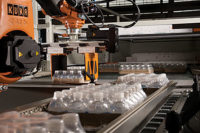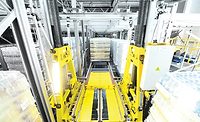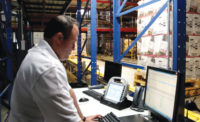Warehouse management and control systems optimize fulfillment strategies
Keeping track of inventory, data analytics key to software solutions

Like a well-oiled machine, warehouse personnel are tasked with driving production and seamlessly moving products from Point A to Point B. Keeping track of orders and inventory, controlling the real-time activities of automated material handling equipment like robots, and retrieving products is engrained in warehouse management systems (WMS) and warehouse control systems (WCS).
Although WMS and WCS operations can work together to streamline storage and retrieval tasks, their capabilities have notable differences. A WMS controls the movement, storage and retrieval of materials and products within a warehouse, handling such core duties as inventory management, lot or batch tracking, order fulfillment and product movement/traceability, explains Dave Williams, vice president of software at York, Pa.-based Westfalia Technologies Inc.
WCS, on the other hand, directly controls the real-time activities of automated material handling equipment and provides communications to programmable logic controllers (PLCs) that operate conveyors, robotics, cranes, etc. as well as printers, barcode readers and scanners, he adds.
Working in tandem, WMS/WCS applications can be crucial for beverage wholesalers. “Wholesalers are utilizing WMS/WCS applications in the beverage industry to help them move product more quickly and efficiently, reduce their inventory levels and increase their order fulfillment accuracy,” Williams explains. “In addition, WMS/WCS applications are being used to bring products to the market in a more efficient manner, thus reducing the cost of goods and the need for larger inventory levels at the retail level of the supply chain.”
Westfalia offers Savanna.NET, a tightly automated system that combines WMS and WCS to help manufacturers and distributors direct, control and optimize internal material flow and order picking. “This two-in-one solution performs the tasks of both systems through a single interface,” Williams says.
With its flexible modular structure supporting conventional and automated warehouses, Savanna.NET is configured to meet diverse business processes. “When users generate orders for fulfillment, the Savanna.NET efficiently breaks the orders into logical units of work and then utilizes its robust warehouse control functionality to direct automated material handling equipment and/or manual labor to execute the work,” Williams explains.
Matt Rivenbark, executive sales manager for SSI Schaefer, Charlotte, N.C., agrees. “Everything these days is about streamlining operations and gaining more throughput in a financially intelligent way,” he says. “For example, a good WMS can boost efficiency by directing operators on where to store and pick items within the warehouse — a huge upgrade for companies that don’t have automated guidance on these activities.
“Second, few WMS systems have the ability to handle labor management and resource planning as well,” Rivenbark continues. “For example, with WAMAS, the WMS from SSI Schaeffer, we’re seeing up to double-digit increases with picking performance. This coupled with resource planning and it really streamlines operations. WMS is where operations are moving in order to boost profit margins.”
With more than 1,000 trained IT experts, the company creates optimized solutions based upon its standardized and proprietary WAMAS, a one-stop, modular logistics software Rivenbark adds.
“We have a complete warehouse management system suite. This includes our WAMAS WMS, WCS, and WES, which handles the material flow, storing, and picking processes within the warehouse,” he says.
In addition, WAMAS also offers a labor and resource management solution. “This technology enables companies to monitor, coach, and analyze picking performance down to an individual level,” he explains. “There is also labor resource planning module, which allows managers to plan resources in the most effective manner. This alone can boost picking performance in the double digits.
“And now, we are introducing our YMS solution for yard management,” Rivenbark continues. “ We also have WAMAS Lighthouse, which incorporates easy to use dashboards that update in real-time. Third party software easily integrates, and it gives users a live update across one or multiple facilities.”
To date, WAMAS has more than 75,000 users and some of the largest names in retail and manufacturers use these products globally, Rivenbark adds.
With beverage market trends like SKU proliferation and diverse packaging types, WMS and WCS operations can offer facility managers various benefits, Westfalia’s Williams notes. The following are some examples:
• Maximize storage utilization: With space at a premium in most beverage warehouses, the more space in a warehouse, the more profitable it can be. The Westfalia solution has the ability to reduce the overall building footprint of a typical beverage warehouse by as much as 50 percent, while reducing energy costs by up to 40 percent in refrigerated warehouse environments, the company says.
• Improve inventory accuracy: Savanna.NET warehouse automation software enables companies to manage stock with pinpoint accuracy, as well as eliminate much of the human error out of the order fulfillment process. By helping to reduce unexpected stock-outs and backorders, and by reducing or eliminating fulfillment errors — wrong products, wrong quantities, etc. — warehousing operations avoid the costly tasks of backorder shipments and return handling or worse yet, losing customers due to fulfillment issues, according to the company.
• Improve product traceability: Traceability throughout the supply chain is becoming a necessity. Savanna.NET enables distributors to accurately track beverage products in real time with the warehouse execution system (WES) pinpointing when shipments arrive, where they are located in the warehouse and when they are scheduled to ship, it adds.
A seamless experience
It’s more important than ever for today’s beverage distributors and wholesalers to be able to deliver the seamless experience clients want — and WMS and WCS are helping to fulfill those expectations.
Through advanced integration services, Ashton Potter, Williamsville, N.Y., can seamlessly integrate its software solution, ProLinc, into existing factory systems in the beverage landscape, enabling producers and manufacturers to uphold quality control, recall management, and compliance standards across the industry’s complex global supply chain, the company said in a statement.
“ProLinc was designed as a seamless extension of the [enterprise resource planning] (ERP) and BI tools already in place, filling the critical gaps left behind by these systems,” Kelly M. Smith, senior vice president of Ashton Potter, said in a statement.
Before implementing a WMS/WCS system, Westfalia Technologies’ Williams suggests that companies consider software sustainability and keep in mind that there are hundreds of applications in the market branded as WMS software. “Key questions to ask include, is the product ‘a one off?’ Is it easily tailored to your specific business needs? Is it Microsoft certified?,” he says. “Firms looking to employ advanced applications such as voice-picking robotics and mobile wireless devices in the near term, should consider looking for software that can integrate with this technology.”
Another factor to be on the lookout for include making sure the vendor offers a high level of support and service. Operators also should evaluate the software features to ensure it meets current and future business needs as well as make sure the WMS/WCS can be integrated with inventory management, lot or batch tracking, order processing functionality and product movement tracking.
To keep pace with today’s beverage warehouse operations, tightly integrated WMS and WCS systems will continue to evolve.
“We will see more warehouses and distributors choosing a WES over separate WMS/WCS systems,” Williams says. BI
Looking for a reprint of this article?
From high-res PDFs to custom plaques, order your copy today!






